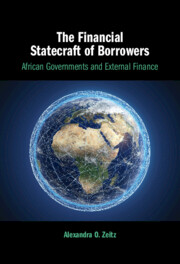4 results
8 - Conclusion
-
- Book:
- The Financial Statecraft of Borrowers
- Published online:
- 12 December 2024
- Print publication:
- 19 December 2024, pp 268-292
-
- Chapter
- Export citation
2 - Theory: The Financial Statecraft of Borrowers
-
- Book:
- The Financial Statecraft of Borrowers
- Published online:
- 12 December 2024
- Print publication:
- 19 December 2024, pp 31-68
-
- Chapter
- Export citation
1 - Introduction
-
- Book:
- The Financial Statecraft of Borrowers
- Published online:
- 12 December 2024
- Print publication:
- 19 December 2024, pp 1-30
-
- Chapter
- Export citation

The Financial Statecraft of Borrowers
- African Governments and External Finance
-
- Published online:
- 12 December 2024
- Print publication:
- 19 December 2024

